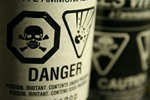What's going into your body?
 Of the thousands of ingredients used on the skin, more than 125 are known or strongly suspected carcinogens, 20 cause adverse nervous system reactions, and 25 are connected to birth defects. Here are some of the more common toxins used in body care products.
Of the thousands of ingredients used on the skin, more than 125 are known or strongly suspected carcinogens, 20 cause adverse nervous system reactions, and 25 are connected to birth defects. Here are some of the more common toxins used in body care products.
Sodium Lauryl Sulfate (SLS)
Used in shampoos for its detergent and foam-building abilities. The American College of Toxicology says that SLS stays in the body up to five days. Other studies show it easily penetrates the skin, and enters and maintains residual levels in the heart, liver, lungs, and even the brain. Particularly in combination with DEA, TEA, and MEA, SLS has been found capable of producing carcinogens. SLS can strip moisture and oils from the skin. It causes eye irritations, skin rashes, hair loss, scalp scurf similar to dandruff, and allergic reactions. According to the Journal of Investigative Dermatology, SLS produces skin and hair damage, including cracking and severe inflammation of the derma-epidermis tissue. According to Japanese studies SLS can damage DNA in cells.
There is no SLS (nor any of its relatives) in Herbaliz Shampoo, Antibacterial Soap, Liquid Soaps or Foaming Hand Soaps! They provide enough suds with no negative side effects.
DEA, MEA, TEA
 These ingredients function as emulsifiers or foaming agents. They are hormone-disrupting chemicals known to form nitrates and nitrosamines, in conjunction with other chemicals present in a product. A Federal government study says that DEA and DEA-based detergents have been shown to greatly increase the risk of cancer, especially liver and kidney cancer... TEA is a skin irritant and may cause dermatitis. TEA causes allergic reactions including eye problems, dryness of hair and skin, and could be toxic if absorbed into the body over a long period of time.
These ingredients function as emulsifiers or foaming agents. They are hormone-disrupting chemicals known to form nitrates and nitrosamines, in conjunction with other chemicals present in a product. A Federal government study says that DEA and DEA-based detergents have been shown to greatly increase the risk of cancer, especially liver and kidney cancer... TEA is a skin irritant and may cause dermatitis. TEA causes allergic reactions including eye problems, dryness of hair and skin, and could be toxic if absorbed into the body over a long period of time.
You won't find DEA, MEA or TEA (nor any variant) in Herbaliz Shampoo, Herbaliz Baby Shampoo, Liquid Soaps or Foaming Hand Soaps! They provide enough suds and you can give them an occasional shake to keep them mixed. No irritants necessary.
Polyethylene Glycol (PEG)
This is used in cleansers to dissolve oil and grease as well as thicken products. A number after "PEG" refers to its molecular weight, which influences its characteristics. Because of their effectiveness, PEGs are often used in caustic spray-on oven cleaners, yet are also found in many personal care products. Not only are they potentially carcinogenic, but they contribute to stripping the skin's natural moisture, leaving the immune system vulnerable.
A note about the glycols: We recently discovered that polyethylene glycol is an "inactive" ingredient in the vitamins we took. Further investigations showed that it is in almost every kind of tablet or caplet we're aware of. One common nsaid pain reliever contained polyethylene glycol, propylene glycol and sodium lauryl sulfate. All the more reason to rely on herbs...and READ LABELS on everything.
Propylene Glycol (PG)
As a "surfactant" or wetting agent and solvent, PG is the active component in antifreeze. There is no difference between what is used in industry and what is used in personal care products. Because of PG's ability to quickly penetrate the skin, the EPA requires workers to wear protective gloves, clothing, and goggles when working with this toxic substance. PG's Material Safety Data Sheets warn against skin contact because PG has systemic consequences, such as brain, liver, and kidney abnormalities.
Looks like the news is out about this ingredient so manufacturers are now using a new name "propanediol." Propanediol IS propylene glycol (or trimethylene glycol)! They're making it with corn now. (I'm thinking ethanol vs petroleum derived gasoline.)
Triclosan

Commonly used in antibacterial soaps, the EPA registers it as a pesticide. Triclosan is a chlorophenol, a class of chemicals suspected of causing cancer in humans. Externally, it can cause skin irritations. Stored in body fat, it can accumulate to toxic levels, damaging the liver, kidneys, and lungs, and can cause paralysis, sterility, suppression of immune function, brain hemorrhage, decreased fertility and sexual function, heart problems, and coma.
There is no need for triclosan; essential oils are naturally and gently antibacterial. Check out Herbaliz Antibacterial Soap, Liquid Soaps or Foaming Hand Soaps!
Quaternary Ammonium Compounds
stearalkonium chloride, benzalkonium chloride, centrimonium bromide, quaternium1-29, quaternuium15Chemicals used in hair conditioners and creams that were developed by the fabric industry as a fabric softener. They can make hair and skin feel softer after use, but repeated use takes away moisture, leaving hair and skin dry and flaky. They are toxic and can cause allergic reactions.
Methyl- Propyl- Butyl- and Ethyl- Paraben
Widely used as inhibitors of microbial growth and to extend shelf life of products, even though parabens are known to be toxic. They have caused many allergic reactions and skin rashes.
Urea (Imidazolidinyl, Diazolidinyl) & DMDM Hydantoin
These are just two of many preservatives that release formaldehyde. They are well established as a primary cause of contact dermatitis (American Academy of Dermatology).
Synthetic Fragrance
Many of the compounds in fragrances are carcinogenic or otherwise toxic. The term "fragrance" on a label can indicate the presence of up to 4,000 separate ingredients. There is no way to know what the chemicals are, since on the label it will simply say "fragrance" or "parfum". Even "natural fragrance" means it is synthetic. Symptoms reported to the FDA have included headaches, dizziness, rashes, skin discoloration, violent coughing and vomiting, and allergic skin irritation.
FD&C or D&C Colors
According to A Consumer's Dictionary of Cosmetic Ingredients, "....many [pigments] cause skin sensitivity and irritation....and absorption [of certain colors] can cause depletion of oxygen in the body, and death". In Home Safe Home, author Debra Lynn Dadd says that "colors that can be used in foods, drugs, and cosmetics are made from coal tar. There is a great deal of controversy about their use, because animal studies have shown almost all of them to be carcinogenic."
Mineral Oil and Petrolatum
Mineral oil was listed in the First Annual Report on Carcinogens in 1980 as "known to be human carcinogens based on sufficient evidence of carcinogenicity in humans." The report states that exposure to mineral oils causes cancer. The primary routes of potential human exposure to mineral oils are inhalation, ingestion, and dermal contact.
In body care products, petroleum ingredients coat the skin like plastic wrap, disrupting the skin's natural immune barrier, inhibiting its ability to breathe. As the body's largest organ of elimination, it is vital that the skin be free to release toxins. Petroleum oils and jellies impede this process, allowing toxins to accumulate, which can promote acne and other disorders. It slows down skin function and cell development, resulting in premature aging of the skin. Mineral oil interferes with the body's own natural moisturizing mechanism, leading to dry skin and chapping.
There are plenty of other ingredients that could make this list. We've chosen the ones most prevalent in body care products. If you believe we have missed an important one, please contact us.

